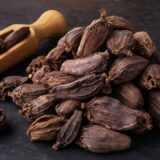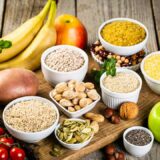Why Ayurveda Recommends Raw Garlic on an Empty Stomach
Garlic (Allium sativum), known as “Rasona” in Ayurveda, has been revered for thousands of years as both a culinary staple and a medicinal powerhouse. Ancient Ayurvedic texts classify garlic as a Rasayana (rejuvenating herb) due to its ability to enhance vitality, boost immunity, and promote longevity. One of the most potent ways to harness its benefits is by consuming raw garlic on an empty stomach. Modern science confirms what Ayurveda has long proclaimed—garlic contains allicin, a sulfur-rich compound with potent antimicrobial, anti-inflammatory, and antioxidant properties.
One of the most potent ways to harness its benefits is by consuming raw garlic on an empty stomach. Modern science confirms what Ayurveda has long proclaimed—garlic contains allicin, a sulfur-rich compound with potent antimicrobial, anti-inflammatory, and antioxidant properties.
When eaten raw, especially in the morning, garlic’s bioavailability increases, allowing the body to absorb its nutrients more effectively.
Garlic – Common Names in Different Languages
- English: Garlic
- Hindi: Lasun
- Sanskrit: Rasonam, Lahsuna
- German: Knoblauch, Knoblauchzweibel
- Chinese (Mandarin): Dà suàn (大蒜)
- Japanese: Taisan (たいさん), Innikiu / Ninniku (にんにく)
- Korean: Taesan (태산 or 대산 – though “Manul/마늘” is more common)
- Hausa (Nigeria): Tafanuwa
- Igbo (Nigeria): Ayoishi
- Swahili (East Africa): Kitunguu saumu
- Yoruba (Nigeria): Ayu
- Nepalese: Lobha (though “Lahsun” is more widely used in Nepal as well)
Ayurvedic Perspective on Garlic
Garlic’s Energetics (Rasa, Virya, Vipaka)
According to Ayurveda, every herb has specific properties that influence the body’s doshas (Vata, Pitta, Kapha). Garlic’s profile is as follows:
- Rasa (Taste): Pungent (Katu)
- Virya (Potency): Heating (Ushna)
- Vipaka (Post-digestive effect): Pungent (Katu)
These qualities make garlic an excellent remedy for balancing Kapha and Vata but may aggravate Pitta if consumed excessively.
Effects on Doshas
- Kapha: Garlic’s heating and drying nature helps reduce mucus, congestion, and sluggish digestion.
- Vata: Its warming properties support circulation and joint health.
- Pitta: In excess, garlic can increase acidity, inflammation, and irritability (best consumed in moderation).
Garlic as a Rasayana (Rejuvenating Tonic)
In Ayurveda, garlic (Lashuna) is highly valued as a potent Rasayana—a rejuvenating substance that promotes longevity, vitality, and resilience. It is traditionally recognized for enhancing:
- Ojas (vital life essence) – supporting immunity and overall vitality
- Agni (digestive fire) – stimulates metabolism and nutrient absorption
- Vyadhikshamatva (immunity) – increasing resistance to diseases
Classical References
- Charaka Samhita (Chikitsa Sthana 1.3.26): Charaka describes Lashuna as Rasayana, especially effective in managing Shotha (inflammation), Vata disorders, and as a general body tonic.
- Sushruta Samhita (Sutra Sthana 46.323): Garlic is noted for its ability to purify the blood, strengthen digestion, and act as an aphrodisiac and rejuvenator.
- Bhavaprakasha Nighantu (Haritakyadi Varga): Lists garlic as a remedy for heart disease, skin disorders, and chronic fevers, and praises its rejuvenative (Rasayana) and adaptogenic effects.
How to Consume Raw Garlic on an Empty Stomach
Why Raw Garlic? Raw garlic (Lashuna) is one of Ayurveda’s most revered herbs for its powerful detoxifying, rejuvenating, and immune-boosting qualities.
When consumed raw, garlic retains its active enzymes and compounds, particularly allicin, which provide potent antibacterial, antiviral, and anti-inflammatory effects.
Eating it on an empty stomach ensures these benefits are absorbed efficiently, supporting overall vitality and balance within the body.
Step-by-Step Method
1. Choose Fresh, Organic Garlic
- The freshness and purity of garlic greatly influence its therapeutic effects. Organic garlic, free from pesticides and chemicals, offers the highest potency.
- Avoid pre-peeled or processed garlic cloves, as these often lose their beneficial oils and enzymes during handling and packaging.
2. Activate Allicin
- Crushing or finely chopping 1–2 cloves releases the enzyme alliinase, which converts alliin into allicin, the active healing compound.
- Allowing the crushed garlic to rest for 5–10 minutes before consumption maximizes the allicin content, ensuring you receive its full therapeutic power.
3. Swallow (Don’t Chew)
- Swallowing garlic with warm water helps wash it down quickly, reducing strong odor and irritation in the mouth or throat.
- For those sensitive to its pungency, mixing crushed garlic with a teaspoon of raw honey can soothe the harshness while providing additional antibacterial benefits.
4. Wait Before Eating
- Waiting for at least 30 minutes before your first meal allows the digestive system to absorb garlic’s active compounds effectively without interference from food.
- This pause also prevents garlic from being neutralized or diluted by stomach acids reacting to food, enhancing its potency as a metabolic and immune stimulant.
5. Ideal Timing
- Morning (Empty Stomach): Consuming raw garlic first thing in the morning supports the body’s natural detoxification processes. It stimulates Agni (digestive fire), helping to jumpstart metabolism and clear toxins accumulated overnight. This practice can improve digestion throughout the day, increase energy levels, and promote clear mental focus.
- Night (Before Bed): Taking raw garlic at night can be particularly helpful for respiratory health. Its expectorant properties aid in loosening mucus and clearing congestion, making breathing easier during sleep. This time is also ideal for calming Kapha dosha imbalances and promoting restful sleep.
Ayurvedic Enhancements
1. With Honey
- Garlic’s heating and pungent nature can aggravate Pitta dosha, which governs heat and metabolism. Mixing it with honey, which has cooling and soothing properties, balances this effect.
- Honey also adds its own antibacterial and immune-enhancing qualities, making the combination a powerful natural remedy for infections and inflammation.
2. With Ghee
- For those with sensitive digestion or prone to gastric irritation, combining garlic with ghee (clarified butter) creates a protective barrier on the stomach lining.
- Ghee is revered in Ayurveda for its ability to nourish tissues and support the absorption of fat-soluble nutrients, thereby enhancing the overall rejuvenating effect of garlic.
3. As a Tonic
- Fermented garlic in honey or garlic-infused sesame oil serves as an excellent long-term Rasayana tonic. Fermentation enhances garlic’s bioavailability and introduces beneficial probiotics, improving gut health and immunity.
- Garlic-infused oils can be used internally or externally to balance doshas, reduce inflammation, and support circulation.
Top 10 Health Benefits of Eating Raw Garlic on an Empty Stomach
Health Benefits of Eating Raw Garlic on an Empty Stomach: Backed by Classical Ayurvedic Wisdom. Boosts Immunity (Enhances Ojas)
- Garlic (Lashuna) is described in Charaka Samhita (Chikitsa Sthana 1.3.26) as a Rasayana that strengthens Ojas, the vital life force responsible for immunity and vitality.
- It is recommended for chronic respiratory infections and fatigue, supporting the body’s natural defense against diseases.
- The antimicrobial property of garlic supports the immune system’s battle against bacteria, viruses, and fungi.
1. Detoxifies Blood & Liver (Reduces Ama)
- In Sushruta Samhita (Chikitsa Sthana 46.323), garlic is praised for its blood-purifying and liver-detoxifying effects, reducing Ama (toxins) that cause skin disorders like eczema and acne.
- It is traditionally used to stimulate liver function and clear blood impurities.
- Ayurvedic texts emphasize its role in balancing Pitta dosha by cleansing toxins and metabolic wastes.
2. Improves Digestion (Ignites Agni)
- Garlic is noted in Bhavaprakasha Nighantu as a stimulant for Agni (digestive fire), promoting bile secretion and enhancing the digestion of fats and proteins.
- It helps relieve symptoms of Agnimandya (weak digestion) such as bloating, gas, and constipation.
- Garlic’s antimicrobial action combats intestinal parasites and pathogenic bacteria, maintaining gut health.
3. Supports Heart Health
- The Charaka Samhita (Sharira Sthana 2.4) references garlic’s ability to improve circulation and reduce Rakta (blood) vitiation, which supports cardiovascular health.
- It helps lower Kapha and Medas (fat), reducing cholesterol and preventing plaque formation in arteries.
- Garlic’s effect on lowering blood pressure is consistent with its action on relaxing blood vessels and balancing doshas.
4. Fights Respiratory Disorders (Balances Kapha)
- Garlic’s expectorant and mucolytic properties are described in Astanga Hridaya (Chikitsa Sthana 6.19) for managing respiratory ailments such as cough, bronchitis, and sinusitis.
- It balances Kapha dosha, reducing mucus congestion and improving lung function.
- Traditionally, it is part of herbal formulas to treat chronic respiratory infections and clear phlegm.
5. Reduces Inflammation & Pain (Balances Vata)
- The anti-inflammatory and analgesic effects of garlic are highlighted in Sushruta Samhita (Chikitsa Sthana 27.75) where it is recommended for arthritis and joint pain.
- Garlic helps balance Vata dosha, which governs movement and nerve impulses, easing stiffness and swelling in conditions like gout and rheumatism.
6. Regulates Blood Sugar (Anti-Diabetic)
- Garlic is cited in Bhavaprakasha Nighantu as useful for controlling blood sugar and improving Madhumeha (diabetes).
- It enhances insulin sensitivity and reduces elevated glucose levels by balancing Kapha and Medas.
- Ayurvedic practitioners use garlic to prevent diabetic complications by reducing oxidative stress.
7. Anti-Parasitic & Anti-Microbial
- Described in Charaka Samhita (Chikitsa Sthana 29.9) as an effective remedy for Krimi (intestinal worms), garlic is used in Ayurveda to treat gut infections and dysentery.
- It is an established natural antibiotic alternative, effective against Candida, H. pylori, and other microbes.
8. Enhances Skin & Hair Health
- Garlic’s blood-purifying qualities support healthy skin, reducing acne and eczema, as mentioned in Ashtanga Hridaya (Chikitsa Sthana 5.56).
- Its antifungal properties are helpful in managing dandruff and scalp infections.
- By improving scalp circulation, garlic promotes healthy hair growth and prevents premature hair loss.
9. May Prevent Cancer (Rasayana Effect)
- The Rasayana property of garlic, mentioned in Charaka Samhita (Chikitsa Sthana 1.3.26), includes its ability to protect tissues and prevent degeneration, which modern research links to cancer prevention.
- Sulfur compounds in garlic support cellular detoxification and apoptosis, inhibiting tumor growth in stomach, colon, and prostate cancers.
- Its antioxidant properties protect DNA from oxidative damage, promoting cellular longevity.
Precautions & Who Should Avoid Raw Garlic
While raw garlic offers many health benefits, it is a potent herb and should be consumed mindfully, especially by certain individuals.
Potential Side Effects
- Heartburn & Acidity: Garlic’s heating and pungent qualities can aggravate Pitta dosha, potentially causing symptoms such as heartburn, acid reflux, or gastric irritation in sensitive individuals.
- Bad Breath & Body Odor: The sulfur compounds responsible for garlic’s therapeutic effects also produce strong odors that can linger on the breath and skin.
- Low Blood Pressure: Garlic naturally lowers blood pressure. People already on antihypertensive (blood pressure) medications should consult a healthcare provider to avoid excessively low blood pressure (hypotension).
- Increased Bleeding Risk: Garlic has blood-thinning properties and can increase the risk of bleeding, especially for those on blood-thinning medications or before surgical procedures.
Who Should Avoid or Use Caution
- Individuals with gastric ulcers, severe acid reflux, or sensitive digestion should avoid raw garlic or consume it under Ayurvedic supervision.
- Pregnant or breastfeeding women should seek medical advice before regular consumption, as garlic’s potency might cause digestive discomfort or other effects.
- People with bleeding disorders or those scheduled for surgery should avoid garlic supplements or high raw doses.
- Children and elderly individuals may require lower doses or alternative preparations to minimize side effects.
Ayurvedic Guidance
- To balance garlic’s heating effect, consume it with cooling agents like honey or ghee, especially if you have a predominant Pitta constitution.
- Moderation is key—start with small amounts to assess tolerance.
- Always consult an Ayurvedic practitioner or healthcare professional for personalized recommendations based on your unique constitution and health status.
Ayurvedic Alternatives for Sensitive Individuals
Raw garlic can be too strong or irritating for some people, especially those with sensitive digestion or aggravated Pitta dosha. Fortunately, Ayurveda offers gentler alternatives that still deliver many of garlic’s health benefits:
1. Cooked Garlic
- Cooking garlic reduces its pungency and heating effect, making it easier on the stomach while retaining mild antimicrobial and antioxidant properties.
- It can be added to soups, stews, and vegetable dishes to support digestion and immunity without overwhelming Agni.
2. Fermented Garlic Honey
- Fermenting garlic in raw honey not only mellows its sharpness but also introduces beneficial probiotics, which support gut health and digestion.
- This preparation is especially soothing for those with sensitive digestion and helps balance Pitta and Kapha doshas.
3. Garlic-Infused Ghee
- Infusing garlic into ghee creates a nourishing and digestive-friendly remedy.
- Ghee’s cooling and soothing qualities balance the heating nature of garlic, making this combination ideal for Pitta types or those prone to gastric irritation.
- Garlic ghee can be used both internally (in small doses) and externally for joint and muscle discomfort.
4. Aged Garlic Supplements (Kyolic Garlic)
- Aged garlic extracts like Kyolic offer the benefits of garlic without the strong odor or harshness.
- The aging process enhances antioxidant properties and reduces pungency, making it suitable for those with sensitive stomachs or who want a convenient supplement form.
Ayurvedic Formulations for Garlic Alternatives
1. Cooked Garlic Tonic
For gentle digestive and immune support
Ingredients:
- 3 cloves fresh garlic, crushed
- 1 cup water or vegetable broth
- 1 tsp fresh ginger, grated
- A pinch of turmeric powder
- Pinch of black pepper
- Salt to taste
Preparation:
- Simmer garlic, ginger, turmeric, and pepper in water or broth for 10–15 minutes.
- Strain and drink warm, preferably in the morning or before meals.
Benefits:
Supports digestion, gently stimulates immunity, and soothes the digestive tract without causing irritation.
2. Fermented Garlic Honey (Lashuna Madhu)
Balances Pitta and Kapha, aids digestion
Ingredients:
- 10 peeled fresh garlic cloves
- 1 cup raw organic honey
Preparation:
- Place garlic cloves in a clean glass jar.
- Pour honey over the garlic, ensuring cloves are fully submerged.
- Seal the jar and keep at room temperature for 7–14 days to ferment, stirring daily.
- Store in the refrigerator after fermentation.
Dosage:
Take 1 teaspoon daily before breakfast or as needed for respiratory or digestive support.
Benefits:
Soothes digestion, balances doshas, boosts immunity, and acts as a natural probiotic.
3. Garlic-Infused Ghee (Lashuna Ghrita)
Nourishes digestion and pacifies Pitta
Ingredients:
- 1 cup organic ghee
- 5–6 cloves fresh garlic, thinly sliced
Preparation:
- Gently warm ghee in a small pan on low heat.
- Add sliced garlic and simmer on the lowest flame for 10–15 minutes, stirring occasionally.
- Remove from heat before garlic browns to avoid bitterness.
- Strain and store the infused ghee in a clean jar.
Dosage:
Take 1 teaspoon internally with warm water or apply externally for joint pain and muscle stiffness.
Benefits:
Easy to digest, balances Pitta, supports digestion, and relieves inflammation.
4. Aged Garlic Supplement (Kyolic-style preparation)
For convenient, odorless antioxidant support
Note: True aged garlic extract is typically prepared commercially through a specialized aging process lasting 20 months or more. While home preparation isn’t practical, you can use high-quality supplements from reputable Ayurvedic suppliers.
Tip: When purchasing, choose supplements that:
- Are certified organic
- Use traditional aging methods (black garlic or Kyolic)
- Contain minimal additives
Dosage:
Follow the product label or Ayurvedic practitioner guidance.
FAQ’s
1. What happens if I eat garlic on an empty stomach?
Eating garlic on an empty stomach may boost immunity, improve digestion, and help detoxify the body. However, some people experience nausea, heartburn, or stomach irritation.
2. What is the 10-minute garlic rule?
The 10-minute garlic rule suggests crushing or chopping garlic and letting it sit for 10 minutes before cooking or eating it. This allows the enzyme alliinase to produce allicin, garlic’s key beneficial compound.
3. Is raw garlic safe to eat in the morning?
Yes, for most people, raw garlic in the morning is safe and may offer benefits like improved metabolism and immunity. But it can cause stomach upset in sensitive individuals.
4. What happens if we eat raw garlic daily?
Daily raw garlic consumption may reduce blood pressure, cholesterol, and inflammation. However, excessive intake can irritate the digestive tract or cause bad breath and body odor.
5. Does garlic burn belly fat?
Garlic may support weight loss indirectly through its effect on metabolism and appetite control, but it doesn’t specifically target belly fat. A healthy diet and exercise are key.
6. What is the best time to eat raw garlic?
The best time is typically in the morning on an empty stomach, to maximize absorption of its active compounds. Drink water afterward to reduce irritation.
7. Is chewing raw garlic good for you?
Chewing raw garlic releases allicin, making it highly potent. It’s good for health but can be harsh on the stomach and mouth, and the strong odor may be unpleasant.
8. How many cloves of garlic per day?
1–2 cloves per day is generally safe and effective for most adults. More than that could cause side effects like heartburn, gas, or bleeding risks (especially if on blood thinners).
9. Is eating raw garlic bad for the stomach?
It can be if consumed in excess or if you have a sensitive stomach. Raw garlic is pungent and may cause acid reflux, gas, or stomach cramps in some individuals.
10. Can I drink water after eating raw garlic?
Yes, drinking water can help reduce the burning sensation and aid digestion. Warm water may be especially soothing.
11. Does garlic clean your gut?
Garlic has antimicrobial properties and may help maintain a healthy gut microbiome. It doesn’t “clean” the gut like a detox, but supports digestive health.
12. Why do I feel pain after eating garlic?
Pain may come from garlic irritating the stomach lining or causing acid reflux. If the pain is consistent, reduce the dose or avoid raw garlic and consult a doctor.
Eating raw garlic on an empty stomach is one of Ayurveda’s most powerful daily rituals for detoxification, immunity, and longevity. While its benefits are vast, moderation and proper consumption are key—especially for Pitta types or those with digestive sensitivities.
References:
- Potential Health Benefit of Garlic Based on Human Intervention Studies: A Brief Overview(1)
- Exploring the health benefits of raw white garlic consumption in humans: a mini review(2)
- Garlic in health and disease(3)
- Health Benefits of Garlic Supplementation(4)
- Proven Health Benefits of Garlic-A Review(5)
























